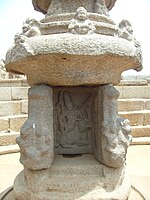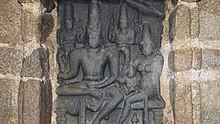Shore Temple
| Shore temple | |
|---|---|
Chengalpattu District | |
| State | Tamil Nadu |
| Country | India |
| Geographic coordinates | 12°36′59″N 80°11′55″E / 12.61639°N 80.19861°E |
| Architecture | |
| Creator | Narasimhavarman II, Pallava dynasty |
| Completed | 630–668 CE |
The Shore Temple (c. 725 AD) is a complex of temples and shrines that overlooks the shore of the Bay of Bengal. It is located in Mahabalipuram, about 60 kilometres (37 mi) south of Chennai in Tamil Nadu, India.[1][2]
It is a structural temple, built with blocks of granite, dating from the 8th century AD. At the time of its creation, the site was a busy port during the reign of Narasimhavarman II of the Indian Pallava dynasty.[3] As one of the Group of Monuments at Mahabalipuram, it has been classified as a UNESCO World Heritage Site since 1984.[4] It is one of the oldest structural (versus rock-cut) stone temples of Southern India.[3]
History
Marco Polo and the European merchants who came to Asia after him called the site Seven Pagodas. One of these is believed to be the Shore Temple. The temple probably acted as a landmark for seafarers. As it appears like a Pagoda, the name became familiar to the seafarers.[5]
This structural temple complex was the
The tsunami of December 2004 that struck the coastline of Coromandel exposed an old collapsed temple built entirely of granite blocks. This has renewed speculation that Mahabalipuram suitshakesiye was a part of the Seven Pagodas described in the diaries of
Though the tsunami of 26 December 2004 that occurred in the Indian Ocean struck the temple and the surrounding garden, the Shore Temple was not badly damaged, as the water level returned to its normal level within a few minutes. The damage was to the foundation of the
According to the two inscriptions found in the slab of smaller Shiva temple, the names of the three temples mentioned are as Kshatriyasimha Pallavesvara-gruham, Rajasimha Pallavesvara-gruham and Pllikondaruliya-devar. The entire temple complex is called as Jalashayana (lying in water). This confirms that the Vishnu shrine was the first shrine to be excavated here. The inscription on the lintel of the Vishnu shrine also mentions this as Narapatisimha Pallava Vishnu Griha where Narapatisimha is a title of Rajasimha.[5]
Architecture

All the three Temples of the Shore Temple complex are built on the same platform. Viewed from the northern end, the temples appear to be a replica of the
The shore temple is one of the most popular temples in Mahabalipuram. Excavations in early 2000s have revealed new structures here under the sand.[10]
The temple is a combination of three shrines. The main shrine is dedicated to
Artwork and iconography

The temple has a
The roofs of the temples have ornamentation similar to the Pancha Rathas. The roofs have

The most distinctive feature of the temple are the

The smaller Shiva temple behind the main temple is a double storied structure with a stepped pyramidal tower with an octagonal shikhara built over a circular griva. A kalasa and finial are fitted above the shikhara. kudus (horseshoe-arch dormer like projections) and small shrines are part of the cornices at both levels of the structure. A Somaskanda panel decorates the back wall of the inner shrine. There is no mantapa (hall) in front of this shrine (probably damaged). The external walls display two panels. One is called Ekapadamurti, an eye-legged form of Shiva with Brahma and Vishnu emanating from his sides. The second panel is of Nagaraja (king of serpents) standing below a five-hooded serpent.[5]
The entire compound wall surrounding the temples is sculpted with large sculptures of Nandi, the vehicle or mount of Shiva, and also with Yalis and Varahas (boars).[8]
Lion monolith

A monolith sculpture of a partly carved and partly sculpted lion with a hole in its torso is erected within the compound wall of the temple complex. A miniature image of
Miniature Shrine
In 1990, the Archaeological Survey of India (ASI) discovered a miniature shrine with the Bhuvaraha image in a well type enclosure. This is dated to the Pallava King Narasimhavarman Mamalla's (AD 638–660) reign. It was enclosed with an elliptical well built during Rajasimha's (AD 700–728) period. These are carved on the bedrock that also has the reclining Vishnu in the Shore Temple complex.[15] The miniature shrine is also dedicated to Shiva.[16][17]

It has sixteen-sided base which is carved from bedrock. The circular wall and superstructure are of structural type. There are lions depicted on the pilasters. It is reported as a unique single tiered temple and not seen in other temples of the Pallava period. Its circular shikara, is in
Conservation
ASI has constructed break-water wall all around the sea shore to save the temple from further damage.[5] The temple structures, affected by rough Sea and winds with salt content are being conserved by the Archaeological Survey of India by building protective groynes, treatment with wall paper pulp, and by planting casuarina trees along the affected coast line. The pulp treatment absorbs the saline water. In addition, chemical treatment is also given the monument to prevent water seepage into the rock. This kind of treatment is also reported to take out water stored inside the rock thus allowing the stone to breathe and preserve its strength. The area around the Shore Temple, has been beautified. The horticulture wing of the ASI has created a green lawn of 11 acres (4.4 hectares) around the Shore Temple. Fixing of signages with information on the monuments and creating fountains was also part of the beautification programme planned by ASI.[20]
Indian Dance Festival-Mamallapuram
The Mamallapuram Dance Festival is held every year during Dec-Jan in Mamallapuram, Tamil Nadu. This dance festival is organised by Department of Tourism, Govt. of Tamil Nadu. Exponents of Bharatanatyam, Kuchipudi, Kathak, Odissi, Mohini Attam and Kathakali perform against this magnificent backdrop of the Pallava rock sculptures. It is vibrant festival of dance where enormous audience enjoys this one month long festival.[21]
See also
Gallery
-
Aerial view of the Shore Temple
-
Shore Temple, left side
-
Shore Temple, right side
-
Shore Temple, View of Shore Temple
-
Shore Temple, Temple Vimanam
-
Shore Temple, c. 1914. Courtesy J.W. Coombes
-
Shore Temple night
-
Shore temple, Mahabalipuram, India.
-
Kathak Danseuse Namrata Rai at Sea Shore Temple
References
- ^ a b "World Heritage Sites – Mahabalipuram: Group of Monuments Mahabalipuram (1984), Tamil Nadu". Archaeological Survey of India by National Informatics Centre. Retrieved 30 December 2012.
- ^ a b "The Shore Temple, Mamallapuram". Onlinenu Library of Encyclopædia Britannica. Retrieved 30 December 2012.
- ^ ISBN 978-0-471-26892-5.
- ^ "Group of Monuments at Mahabalipuram". World Heritage. Retrieved 8 February 2007.
- ^ a b c d e f g h i j k l m n "Mahabalipuram – The Workshop of Pallavas – Part V". Shore Temple. Puratatva.com. 14 September 2010. Archived from the original on 23 January 2014. Retrieved 27 February 2013.
- ^ "Mahabalipuram". USCLA Education, South Asia. Archived from the original on 6 October 1999. Retrieved 30 December 2012.
- ISBN 978-1-4262-0336-7. Retrieved 7 February 2013.
- ^ a b "The Shore Temple stands its ground". The Hindu. 30 December 2004. Archived from the original on 30 December 2004. Retrieved 30 December 2012.
- ISBN 978-0-7946-0011-2.
- ^ "The Shore Temple stands its ground". The Hindu. Chennai, India. 30 December 2004. Archived from the original on 30 December 2004. Retrieved 8 February 2007.
- ISBN 978-0-226-53230-1.
- ^ "Mamallapuram". Art and Archaeology.com. Retrieved 30 December 2012.
- ^ "Somaskanda". Art and Archaeology.com. Retrieved 27 February 2013.
- ISBN 978-81-208-1391-5. Retrieved 27 February 2013.
- ^ "World Heritage Sites – Mahabalipuram – Excavated Remains". Archaeological Survey of India through National Informatics Centre. Retrieved 27 February 2013.
- ^ Rajarajan, R.K.K. (1996). "Vṛṣabhavāhanamūrti in Literature and Art". Annali del Istituto Orientale, Naples. 56 (3): 305–10.
- ^ Rock-cut Model Shrines in Early Medieval Indian Art.
- ^ Rajarajan, R. K. K. "Vṛṣabhavāhanamūrti in Literature and Art". Annali del Istituto Orientale, Naples.
- ^ "World Heritage Sites – Mahabalipuram – Excavated Remains". Archaeological Survey of India through National Informatics Centre. Retrieved 30 December 2012.
- ^ "A monumental effort". Front Line India's National Magazine from the publishers of The Hindu. 8 November 2003. Archived from the original on 10 April 2013. Retrieved 27 February 2013.
- ^ "Mamallapuram Dance Festival - Dance Festivals - Webindia123.com". www.webindia123.com.













